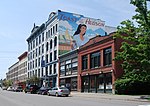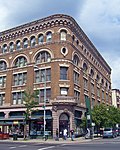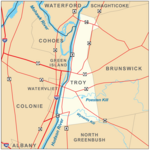Troy Waste Manufacturing Company Building
1908 establishments in New York (state)Buildings and structures in Rensselaer County, New YorkIndustrial buildings and structures on the National Register of Historic Places in New York (state)Industrial buildings completed in 1908National Register of Historic Places in Troy, New York ... and 3 more
Neoclassical architecture in New York (state)Rensselaer County, New York Registered Historic Place stubsTextile mills in New York (state)
Troy Waste Manufacturing Company Building, also known as the McCarthy Building, is a historic textile factory located at Troy, Rensselaer County, New York. It was built about 1908, and is a five-story, triangular shaped brick building with a flat roof and high basement. It features a tall square stair tower, formal entranceway, and Classical Revival style terra cotta ornamentation.: 6 It was listed on the National Register of Historic Places in 2014.
Excerpt from the Wikipedia article Troy Waste Manufacturing Company Building (License: CC BY-SA 3.0, Authors).Troy Waste Manufacturing Company Building
Green Island Bridge, City of Troy
Geographical coordinates (GPS) Address Nearby Places Show on map
Geographical coordinates (GPS)
| Latitude | Longitude |
|---|---|
| N 42.736388888889 ° | E -73.689166666667 ° |
Address
Green Island Bridge
Green Island Bridge
12181 City of Troy
New York, United States
Open on Google Maps









